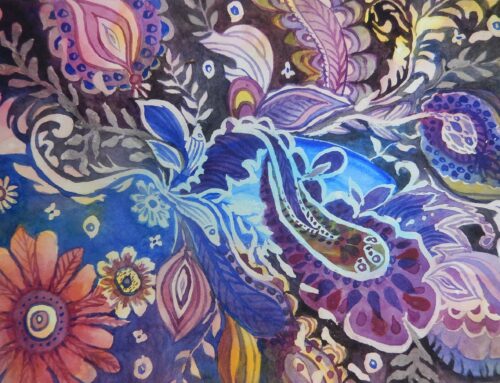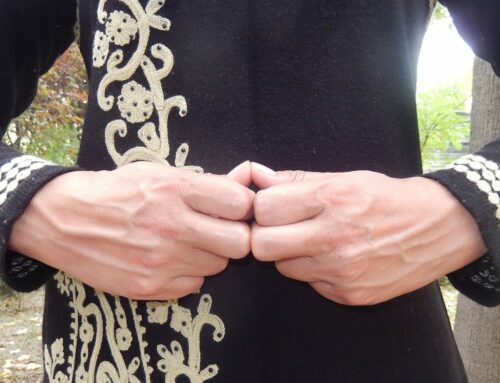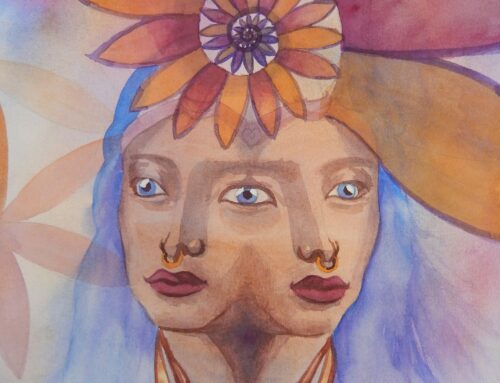Traduction de la présentation de Felicitas Goodman pour l’Institut Cuyamungue
Formation académique
Felicitas Maria Johanna Daniels est née de parents allemands ethniques à Budapest, en Hongrie, le 30 janvier 1914. Elle était l’aînée de deux enfants. Dans sa jeunesse, elle a été éduquée par l’ordre catholique romain des religieuses Ursulines, bien que sa famille fût luthérienne. Jeune femme, elle fréquente l’Université de Heidelberg (Allemagne) et obtient en 1936 son diplôme d’interprète. C’est là qu’elle a rencontré son futur mari, Glenn H. Goodman, un Américain de l’Ohio.
En 1947, Felicitas, Glenn et leurs trois premiers enfants immigrent à Columbus, Ohio, où Glenn devint professeur d’allemand à l’Université d’État de l’Ohio. Son quatrième enfant est né quelques années plus tard. Pendant cette période, Felicitas enseigne l’allemand et l’anglais et travaille comme traducteur d’articles scientifiques.
En 1965, alors qu’elle avait 51 ans et que ses enfants grandissaient, elle retourna à l’école supérieure en terminant une maîtrise à l’Université d’État de l’Ohio en linguistique en 1968 et un doctorat en anthropologie culturelle en 1971. De 1968 jusqu’à sa retraite forcée en 1979, à l’âge de 65 ans, elle enseigne la linguistique, l’anthropologie culturelle et les religions comparées à l’Université Denison de Granville, en Ohio. Elle quitte ce monde le 30 mars 2005 à Colombus, Ohio.
Contributions à l’anthropologie
Felicitas Goodman a apporté deux contributions majeures dans le domaine de l’anthropologie : l’une concernait la « glossolalia » ou « parler en langue » (encore appelé protolangage), l’autre concernait la transe extatique religieuse.
Alors qu’elle plongeait dans ses études anthropologiques de deuxième cycle, Felicitas a noté des discussions fréquentes sur un type étrange de discours que les gens parlaient alors qu’ils étaient « possédés ». En tant que linguiste, cela l’intriguait. Les ethnographes l’appelaient « discours inintelligible » ou « charabia inintelligible ». Ce discours lui rappelait des histoires bibliques sur les « langues inconnues » prononcées par les Apôtres à la Pentecôte (Actes 2:1-13). Pour un séminaire en linguistique anthropologique dirigé par Erika Bourguignon à l’Ohio State, Felicitas a choisi la « glossolalia » comme sujet de son article.
Le Dr Bourguignon lui a fourni des bandes sonores de ces discours provenant de confessions pentecôtistes de l’Ohio, du Texas et des Caraïbes. Sur la base de cette recherche, elle a développé une hypothèse de travail désignant que les modèles frappants d’accent et d’intonation de cette parole, ainsi que certaines caractéristiques phonétiques, n’étaient pas un type différent de langage naturel, qui était la « vue reçue » dans son domaine. Ces caractéristiques exprimaient des changements corporels qu’une personne a subis pendant la transe, accompagnant ou peut-être même facilitant l’expérience religieuse. (1969. « analyse phonétique de glossolalia en quatre contextes culturels ». Journal for the Scientific Study of Religion. 8: 227-239.)
Pour tester son hypothèse plus avant et explorer son importance interculturelle possible, elle a mené des travaux sur le terrain avec les pentecôtistes hispanophones à Mexico en 1968. Cette expérience a validé son hypothèse : les syllabes prononcées pendant la parole en langues étaient différentes, mais le modèle d’accent et d’intonation, ainsi que certaines caractéristiques phonétiques, étaient les mêmes. Ils semblaient biologiquement fixés.
Mais ces idées s’en tiendraient-elles aux langues non indo-européennes ? Elle a mené d’autres travaux sur le terrain parmi les locuteurs mayas (pentecôtistes) dans le Yucatan, ce qui a confirmé son hypothèse. Son étude reste le mot définitif sur ce phénomène à ce jour. (1972. Speaking in Tongues: A Cross-cultural Study of Glossolalia. Chicago: University of Chicago Press; 2001. Maya Apocalypse: Seventeen Years with the Women of a Yucatan Village. Bloomington et Indianapolis: Indiana University Press). La Glossolalia est simplement une vocalisation modelée sans contenu.
Transe extatique religieuse
Les recherches, les publications et l’expérience continue de Felicitas Goodman dans ce domaine sont sa principale contribution à l’anthropologie. Dans son livre, Where the Spirits Ride the Wind (1990, Bloomington and Indianapolis: Indiana University Press), elle note à quel point l’expérience de transe faisait partie intégrante de sa vie, jusqu’à l’âge de la puberté quand on lui a conseillé de laisser derrière elle les expériences de l’enfance. Heureusement, Felicitas n’a pas fait cela. L’intérêt est resté en elle tout au long de sa vie. Felicitas a reconnu deux dimensions à la réalité : consensuelle et alternative. La réalité consensuelle est l’arène de l’expérience humaine commune, ordinaire. La réalité alternative est parallèle à la réalité consensuelle. C’est la demeure des esprits, des ancêtres. C’est, bien sûr, la façon dont Felicitas a compris et interprété la réalité dans le monde occidental contemporain. C’était très différent dans l’Antiquité. Jusqu’à l’époque d’Origen (vers 253 après JC), la notion de « surnaturel » n’existait tout simplement pas. La réalité était une : les esprits, les dieux, les ancêtres et les humains vivaient dans un seul monde. C’est pourquoi les rapports bibliques et autres rapports anciens parlent d’humains communiant avec des esprits, des divinités ou des ancêtres sur une base régulière.
Felicitas croyait que le monde des esprits (la demeure de la divinité et de l’entourage de la divinité) pouvait être accessible par les humains, et ce principalement dans un état alternatif de conscience (EAC). Avec ses étudiants à l’Université Denison, elle a développé un rituel pour entrer dans l’EAC et entrer en contact avec le monde des esprits. Le rituel est essentiel à ce contact.
L’Institut Cuyamungue à Santa Fe, NM
Felicitas est allé avec des amis de l’Université d’État de l’Ohio à Santa Fe, Nouveau-Mexique. Elle est tombée amoureuse du lieu et de la culture amérindienne ambiante presque immédiatement. Elle a commencé à chercher de petites propriétés dans la région, et en 1963 son agent immobilier a trouvé 270 acres pour elle (plus qu’elle ne voulait) dans la région connue sous le nom de Cuyamungue, le nom d’un ancien pueblo dans la région. En 1965, accompagnée d’amis et de parents, elle découvre un lieu pour ériger un bâtiment sur sa propriété, et c’est ainsi que l’Institut a vu le jour.
Parce qu’elle a continué de vivre à Columbus, OH, elle a partagé son temps entre cet état et Cuyamungue. En 1978, le Dr Goodman a fondé l’Institut qui est aujourd’hui connu sous le nom de Cuyamungue: The Felicitas D. Goodman Institute qui poursuit ses recherches sur les états de conscience altérés et organise des ateliers sur les postures qui sont l’une des portes de la réalité alternative.
La plus grande contribution de Felicitas Goodman à l’anthropologie a été de reconnaître que les images sur la poterie et dans les œuvres d’art anciennes étaient des instructions rituelles. « Si l’on adopte telle posture, on aura telle expérience. » Ces images ne sont pas des connaissances secrètes, mais ont plutôt été exposées abondamment dans des expositions de musées, des volumes d’histoire de l’art et même dans des bijoux populaires. Cependant, personne n’a pensé à leur signification comme autre chose que les créations aléatoires d’artistes autochtones jusqu’à ce qu’elle commence à explorer leurs utilisations dans un contexte rituel.
En développant une méthode prescrite par laquelle les individus ordinaires sont capables d’entrer dans l’état de conscience modifié religieux, elle a fait une enquête technique sur cet état à la fois d’un point de vue phénoménologique et physiologique. Un avantage de cette méthode est que le sujet est stationnaire, ce qui permet de mener des recherches neurophysiologiques. De plus, les sujets sont en mesure de décrire leurs expériences en des termes compréhensibles pour l’enquêteur.
Publications
Au cours de sa carrière d’anthropologue, Mme Goodman a publié 12 livres et de nombreux articles publiés dans des revues professionnelles, notamment :
- Where the Spirits Ride the Wind: Spirit Journeys and Other Ecstatic Experiences, Indiana University Press, Bloomington, 1990.
- Ecstasy, Ritual, and Alternate Reality: Religion in a Pluralistic World, 1988
- Speaking in Tongues: A Cross-Cultural Study of Glossolalia, The University of Chicago Press, Chicago, 1972.
- My Last Forty Days: A Visionary Journey among the Pueblo Spirits, 1997.
- Disturbances in the Apostolic Church: A Trance-Based Upheaval in Yucatán, In Trance, Healing, and Hallucination: Three Field Studies in Religious Experience, by Felicitas D. Goodman, Jeannette H. Henney, and Esther Pressel, Wiley Interscience, New York, 1974.
- The Exorcism of Anneliese Michel, Doubleday, New York, 1981 (translated into German and French)
- How About Demons? Possession and Exorcism in the Modern World, Indiana University Press, Bloomington and Indianapolis, 1988. (translated into German)
- Trance Der uralte Weg zum religioesen Erleben, Gütersloher Verlagshaus, Gerd Mohn, 1992. (translated into Dutch, Hungarian, and Spanish)
- Maya Apocolypse: Seventeen Years with the Women of a Yucatan Village Indiana University Press, Bloomington and Indianapolis, 2001.
- Possible Physiological Mechanisms for Some Cases of Faith Healing, Medikon 3(6/7):39-41, 1974.
- States of Consciousness: A Study of Soundtracks. Journal of Mind and Behavior 2:209-219, 1981.
- Body Posture and the Religious Altered State of Consciousness: An Experimental Investigation, Journal of Humanistic Psychology, 26:81-118, 1986.
- A Trance Dance with Masks, The Drama Review, 34(1):102-113, 1990.
- Ritual Body Postures and Ecstatic Trance: Implicit Myths and Healing, Yearbook of Cross-Cultural Medicine and Psychotherapy, 1998/99: 43-50.
- Ritual Body Postures, Channeling, and the Ecstatic Trance, Anthropology of Consciousness 10 (1): 54-59.
Autres Publications
1945: Die Blaue Brücke. Fairy Tales by Felicitas Goodman. Karlsruhe: Schwerdtfeger Publishing House.
1965: “Immer noch…” A Poem. P. 47 in Um den Schlaf Gebracht. Karlsruhe: Rüdiger.
1969: “Phonetic Analysis of Glossolalia in Four Cultural Settings.” Journal for the Scientific Study of Religion. 8: 227-239.
1969: “Glossolalia: Speaking in Tongues in Four Cultural Settings.” Confinia Psychiatrica 12: 113-129.
1971: “Glossolalia and Single Limb Trance: Some Parallels.” Psychotherapy and Psychosomatics 19: 92-103.
1972: Speaking in Tongues: A Cross-cultural Study of Glossolalia. Chicago: University of Chicago Press.
1973: “Glossolalia and Hallucination in Pentecostal Congregations.” Psychiatria Clinica 6: 97-103.
1973.: “The Apostolics of Yucatan: A Case Study of a Religious Movement.” In Religion, Altered States of Consciousness, and Social Change. Erika Bourguignon, ed. Columbus, OH: Ohio State University Press, pp. 178–218.
1973: “Limits to Cultural Conditioning: Glossolalia in the United States in Cross-Cultural Perspective.” Paper presented to the 72nd Annual Meeting of the American Anthropological Association, New Orleans, 29 November 1973.
1974: “Disturbances in the Apostolic Church: A Trance-Based Upheaval in Yucatán.” In Trance, Healing and Hallucination by Felicitas Goodman, Jeannette M. Henney, and Esther Pressel. New York: Wiley Interscience, pp. 227–364.
1974: “Not to Speak in Tongues: Abstention from Glossolalia in a Yucatecan Crisis Cult. (Paper prepared for the session on “Sociology of Language and Religion.” Eighth World Congress of Sociology. Toronto, Canada, August, 1974).
1975: “The Effect of Trance on Memory Content.” Psychiatria Clinica 8: 243-249.
1975: “Some biological aspects of glossolalia.” In Ghosh Biology and Language. New York: Academic Press. (Check source).
1975: “Belief Systems, Millenary Expectations, and Behavior.” pp. 130–138 in Symbols and Society: Essays on Belief Systems in Action. Southern Anthropological Society Proceedings, Nol 9. Carole E. Hill, ed. Athens, GA: Southern Anthropological Society.
1980: “Triggering of Altered States of Consciousness as Group Event: A New Case from Yucatan.” Confinia Psychiatrica 23: 26-34.
1980: Anneliese Michel und ihre Dämonen. Stein am Rhein: Christiana.
1980: “Women in Yucatán.” pp. 213–233 in A World of Women. Erika Bourguignon and all contributors. New York: Praeger.
1981: “States of Consciousness: A Study of Soundtracks.” The Journal of Mind and Behavior 2: 209-219.
1981: The Exorcism of Anneliese Michel. Garden City: Doubleday and Co., Inc.
1985: Dreamtime: Concerning the Boundary between Wilderness and Civilization. By Hans Peter Duerr. Translated by Felicitas Goodman. Oxford: Blackwell.
1985: “Learning the Daybreak Song.” pp. 94–103 in A Time to Weep; A Time to Sing: Faith Journeys of Women Religious Scholars of Religion. Mary Jo Meadow and Carole A. Rayburn, eds. Minneapolis, MN: Winston.
1986: “Body Posture and Religious Altered State of Consciousness: An Experimental Investigation.” Journal of Humanistic Psychology 26: 81-118.
1986: “Spontaneous Initiation Experiences in an Experimental Setting.” pp. 68–80 in Proceedings of the Third International Conference on the Study of Shamanism and Alternate Modes of Healing. (Check pages).
“Singing Shaman Ritual (experiential).” In the same volume; check pages.
1987: “Shamanic Journey (experiential session).” pp. 112–122 in Proceedings of the Fourth International Conference on the Study of Shamanism and Alternate Modes of Healing.
1987: Anneliese Michel und ihre Dämonen. 2nd ed. Stein am Rhein: Christiana.
1987: `Visions.’ In The Encyclopedia of Religion. Mircea Eliade, ed. New York: Macmillan. Vol.15: 282-88. Also “Glossolalia.” Check volume and pages.
1988: “Shamanic Trance Postures.” pp. 53–61 in Shaman’s Path. Healing, Personal Growth, and Empowerment. Compiled and edited by Gary Dore.
1988: Ecstasy. Ritual and Alternate Reality; Religion in a Pluralistic World. Bloomington: Indiana University Press.
1988: How About Demons: Possession and Exorcism in the Modern World. Bloomington: Indiana University Press.
1988: “The Nature of Ego in Experimental Shamanism (including experience and discussion). Pp. 215-224 in the Proceedings of the Fifth International Conference on the Study of Shamanism and Alternate Modes of Healing.
1989: Wo die Geister auf den Winden reiten. Freiburg im Breisgau: Hermann Bauer.
1989: “The Neurophysiology of Shamanic Ecstasy.” pp. 377–379 in Shamanism Past and Present. Vol 2. Mihály Hoppál and Otto von Sadovszky, eds.
1989: “Beware the Symbols: The Shaman Rides a Horse.” Pp. ???-??? in Proceedings of the Sixth International Conference on the Study of Shamanism and Alternate Modes of Healing.
1990: “The Oldest Shaman is a Shamaness: Spirit Journey with the Galgenberg Figurine.” pp. 303–312 in the Proceedings of the Seventh International Conference on the Study of Shamanism and Alternate Modes of Healing.
1990: “A Trance Dance with Masks: Research and Performance at the Cuyamungue Institute.” The Dance Review 34: 102-114.
1990: Jewels on the Path. a Spirit Notebook . Santa Fe: the Cuyamungue Institute.
1990: Where the Spirits Ride the Wind: Trance Journeys and Other Ecstatic Experiences. Bloomington: Indiana University Press.
1991: Ekstase, Besessenheit, Dämonen: Die geheimnisvolle Seite der Religion. Gütersloh: Gütersloh Publishers.
1991: “A Masked Trance Dance.” pp. 259–264 in the Proceedings of the Eighth International Conference on the Study of Shamanism and Alternate Modes of Healing.
1992: “Alte Wege neu gegangen.” In ab 40, 1 (1992) 96-103. (A German language magazine by, for, and about women. How they live, what they think, who they are. After the age of 40. Felicitas translated it pro manuscripto).
1992: Trance: der uralte Weg zum religiösen Erleben. Rituelle Körperhaltungen und ekstatische Erlebnisse. Gütersloh: Güterloh Publishing House.
1993: “The Nazca Lines: A New Hypothesis.” pp. 262–273 pp. 68–60 in Proceedings of the Tenth International Conference on the Study of Shamanism and Alternate Modes of Healing.
1993: Panel Discussion on Healing Interethnic Relationships with Royal E. Alsup, Ann Goodman, Ruth-Inge Heinze, and Jack Norton. Same Volume; check pages.
1993: “Ekstase,” and “Magie.” pp 62–67; 190-195, in Wörterbuch der Religions Psychologie. Siegfried Rudolf Dunde, ed. Gütersloh: Gütersloh Publishing House.
1993: Wo die Geister auf den Winden reiten. Trancereisen und ekstatische Erlebnisse. 3rd edition. A corrected version. of 1989.
1993: “Das Erlebnis der Besessenheit.” Manuskripte: Zeitschrift für Literatur 121a: 56-67.
1994: Die andere Wirklichkeit: Das Religiöse in einer pluralistischen Gesellschaft. Munich: Trickster.
1994: Jewels on the Path. A Spirit Notebook. Volume II. Santa Fe: the Cuyamungue Institute
1994: “The Animal Connection.” pp. 226–234 in the Proceedings of the Eleventh International Conference on the Study of Shamanism and Alternate Modes of Healing.
1994: “Shamans, Witches, and the Rediscovery of Trance Postures.” pp. 15–33 in Witchcraft Today. Book Three. Witchcraft and Shamanism. Chas. S. Clifton, ed. St. Paul, MN: Llewellyn Publications.
1994: Lichaamshoudingen: en hun spirituele mogelijkheden. Tr. By Gerhard Grassman. (Dutch translation of Trance [Gütersloh, 1992]).
1995: “Shamanic Journey (Experiential).” pp. 151–154 in the Proceedings of the Twelfth International Conference on the Study of Shamanism and Alternate Modes of Healing.
1996: Meine Letzten 40 Tage: Eine indianische Vision über das Sterben und den Tod. Zürich and Düsseldorf: Walter.
1996: “Rituelle Körperhaltungen und ekstatische Erlebnisse.” Imagination (Formerly Ärtzliche Praxis und Psychotherapie) 2: 26-40.
1996 : “The Locked Door of Paradise: Closed versus Open Religious Systems .” Pp. ???-??? in Proceedings of the Thirteenth International Conference on the Study of Shamanism and Alternate Modes of Healing.
1996: “Shamanic Journey (Experiential).” Same Volume; check pages.
1997: “Ritual Body Postures, Channeling, and the Ecstatic Body Trance.” Jahrbuch für Ethnomedizin und Bewusstseinsforschung / Yearbook for Ethomedicine and the Study of Consciousness. Christian Rätsch and John R. Baker. 6-7: 71-76.
1997: My Last Forty Days: A Visionary Journey among the Pueblo Spirits . Bloomington and Indianapolis, IN: Indiana University Press (check).
1998: Ekstatische Trance: Neue rituelle Körperhaltungen, das Arbeitsbuch. With Nana Nauwald. Edition Nada, Bad Bevensen.
1999: Die blaue Brücke. Bad Bevenson: Nada. A new edition of 1945 with color illustrations by Nana Nauwald.
2000: “Trance, Posture, and Ritual: Access to the Alternate Reality.” Pp ???-??? in The Nature and Function of Rituals: Fire From Heaven. Ruth Inge-Heinze, ed. Portsmouth, NH: Greenwood Publishing Group.
2001: Maya Apocalypse: Seventeen Years with the Women of a Yucatán Village. Bloomington and Indianapolis: Indiana University Press.
2002: Utolsó Negyven Napom: Látomásos utazás a pueblo szellemek közöt. Szentendre: Leviter Kiadó.
2003: Ecstatic Trace: A Workbook. New Ritual Body Postures. With Nana Nauwald. Havelte, Netherlands: Binkey Kok Publications. Translation of 1998
2003: Der Åndene Rir Vinden. Transereiser og andre ekstatiske erfaringer. Norwegian translation of Where the Spirits Ride the Wind: Part 1: The Search for the Spirits. Tvedestrand: eutopiA publishing house.
2004: Hvordan flyh med åndene
2005: Myter fra den evige nåtid.
2005: The Exorcism of Anneliese Michel. Reprint of 1981 by Wipf & Stock, Eugene, OR.
n/d: TranceRituale für Jugendliche. ReEducation #181. Werner Pieper’s MedienXperimente. D-69488. Löhrbach. Austria. (This was given to Frances to have translated by a friend of the Institute.)
Livres
Ecstatic Body Postures: An Alternate Reality Workbook”, Bear & Company; Original ed. edition (May 1, 1995) 1879181223 (10), 978-1879181229 (13)
Ecstasy, Ritual and Alternate Reality: Religion in a Pluralistic World, Indiana University Press; Edition: Reissue (1. Dezember 1988), ISBN 0-253-31899-8 (10), ISBN 978-0-253-31899-2 (13)
The Exorcism of Anneliese Michel, Resource Publications (OR) (November 2005), ISBN 1-59752-432-8 (10), ISBN 978-1-59752-432-2 (13)
How About Demons?: Possession and Exorcism in the Modern World, (Folklore Today), Indiana University Press (1. Mai 1988), ISBN 0-253-32856-X (10), ISBN 978-0-253-32856-4 (13)
S.T., second cycle de Kali 2023, Provence








Laisser un commentaire